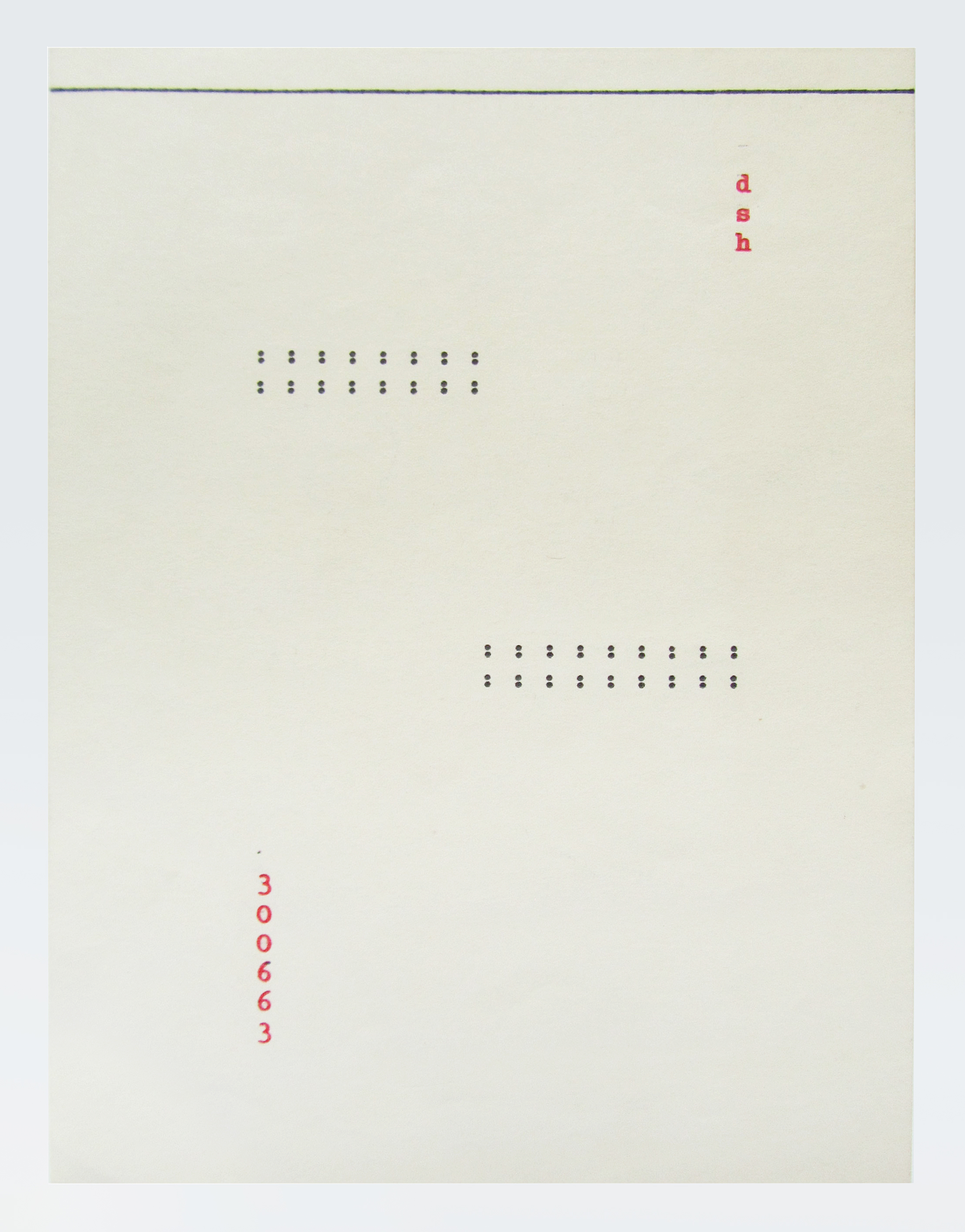Dom Sylvester Houédard
A selection of rare typestracts, sculptural works, thermographs, original reversal poems, prints and books by Dom Sylvester Houedard (dsh). Dsh was a benedictine monk, concrete poet and avant-garde figure associated with Lisson Gallery and Writer’s Forum in the late 1960s and is seen as Britain’s master of Typewriter Art.
Typestracts by dsh
dsh produced visual poems (typestracts) on his portable Olivetti typewriter. They were often made using red, blue and black ink ribbons.
la recreation de l’homme a l’image de dieu, 1969.
152 x 115mm approx. Typestract red and black on white paper stock. Typed signature and dated 050369. This work was published in Kontexts 2 (edited by Michael Gibbs). It is rare to find dsh typestracts that have been published in his lifetime. Exhibited at South London Gallery Conference 2014.
POA
mind trip (trap), 1968
Clapperboard poem, 565 x 150 mm. Five painted wooden boards (each 111 x 150 x 5 mm) connected by a series of nylon bands, stencilled text on both sides. Unsigned and undated (1968).
mind trip (trap) by Dom Sylvester Houedard (dsh) is the most significant sculpture known to have survived from the 1960s by the Benedictine monk. The discovery of this sculpture in the Ken Cox Estate in 2012 has provided a more complete understanding of the depth of work that dsh engaged in. It was constructed for dsh by his friend and fellow member of gloup (‘Glo’ster Gro’up of Concrete and Kinetic Poets’), the machine poet Kenelm Cox, in his studio at Kingscote. The work consists of a series of painted wooden panels, each with a single stencilled letter, which are connected by a nylon tape pulley system. When the top board is rotated 180 degrees the other boards flip to their reverse side so the words ‘mind’ and ‘trip’ become interchangeable, creating a type of ‘jacob’s ladder’. The top board has bolts and a metal insert that would have originally connected to a rotating mechanical device.
As such, it is the only one of dsh’s early mechanical poem projects to have been made. Sketches and ideas for other poemsculptures can be found in a detailed letter to Cox, dated 1966, but any preliminary thoughts or sketches for mind trip as yet remain unfound.
That Cox was “ very keen” to collaborate with dsh on a number of pieces is made clear in dsh’s essay the singing of feeling, and, had Cox not died so tragically in 1968, it seems very likely that some of the other poemsculptures would have been made. It is in this same essay that dsh hints at the thoughts behind the construction of mind trip:
[…] the model of the Jacob-ziggurat constructed on the principle of a well known toy & using the text mindtrip/mind trap – here of course the form was largely given by the construction & the materials were limited by its functioning […]
In a tantalising anecdote, dsh then suggests that the artists may have had further ambitions for this piece, perhaps on the scale of Cox’s own work The Three Graces, where the words ‘Beauty’ ‘Passion’ and ‘Love’ floated 30 foot high out at sea, a little way from Brighton Beach:
[…] on one of the most memorable drives I had back from London with ken we discussed the possibility of building the trip-trap on a huge scale – 100 feet high on a glostershire hill- perhaps phosphorescent – but ideally seen making its great serene clapping noises against the storm flash & gale of wild mud & night [...]
mind trip is the only surviving work from what dsh calls the “tantric-staircases series” and while it is not on the same scale as The Three Graces, it still stands as the largest existing sculptural work by dsh. The rest of the series were lost “en route to the stedlijk museum” in 1968. As a “tantric staircase,” the work animates the spiritual ladders that characterise so many of the typestracts. As dsh states elsewhere in his ecumenical writing: “[the] ladder is our life of contemplation”, as we descend to our nothing heart centre we ascend to God, “the down which we climb to the top”. Or as dsh puts it in an earlier beat style lyric: “the streets go both crazy ways at once.”
It is characteristic of dsh to create neologisms for this movement of mind (central to him), for the act of contemplation is found both in the making and seeing of his kinkon and poemobjects: ‘right mind-minding’, ‘mind-turning’, ‘mind-stilling’, ‘mind-holding’. But it is perhaps in mind trip where, in Cox’s words, an “indivisible unity between the words & the movement” is most successfully realised, and not least because of this collaboration.
As a postscript, it is worth remembering that mind trip was made in the 1960s and the paranomasia between dsh’s contemplative inner journey and the groovy psychedelic, countercultural parlance for dropping an LSD tab is very much intended.
Nicola Simpson, 2015
For further information about this work, please phone:
+44 (0) 208 693 3871
+44 (0) 7946 856835
Or send us an email.







